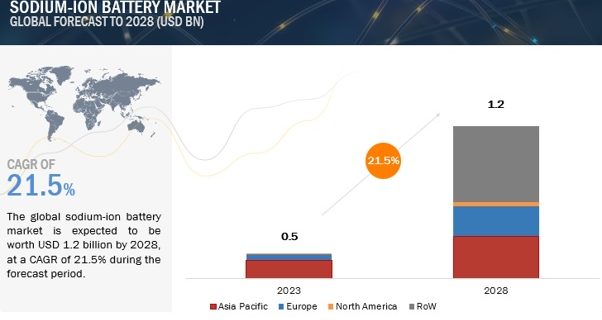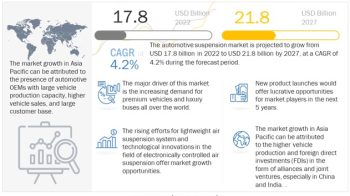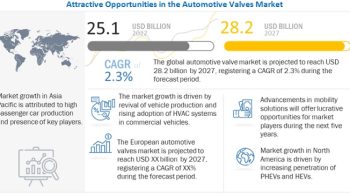
The global sodium-ion battery market is projected to grow from USD 0.5 billion in 2023 to USD 1.2 billion by 2028, at a CAGR of 21.5 % during the forecast period. Technological advancements are propelling market growth, with ongoing research enhancing the performance and efficiency of sodium-ion batteries. Government support and policies, including incentives and regulations, further boost the market by promoting the use of sodium-ion batteries. Additionally, the expansion of the electric vehicle market and the increasing adoption of sodium-ion batteries in various industries like telecommunications, aerospace, and healthcare are contributing to drive the sodium-ion battery market.
Request For FREE Sample of Report at https://www.marketsandmarkets.com/requestsampleNew.asp?id=207269067
Based on end-use, the energy storage end-use segment is accounted as the largest in the market, in terms of value during the forecast period. As the renewable energy source is increased, such as solar and wind, into the grid has made efficient energy storage solutions to manage the intermittent nature of these sources. Sodium-ion batteries are well-suited for this purpose as it has ability to store large amounts of energy and discharge it when needed. The growth in electric vehicle market is driving the demand for energy storage solutions. Sodium-ion batteries are being increasingly used in EVs as they offer a eco-friendly and cost-effective alternative to lithium-ion batteries. Additionally, sodium-ion batteries have a higher energy density compared to other types of batteries, making them ideal for use in EVs.
Based on technology, the non-aqueous is accounted for the largest share, in terms of value, during the forecast period. Non-aqueous sodium-ion batteries use non-aqueous electrolytes, which offer higher energy densities and longer cycle lives compared to aqueous electrolytes. This makes them ideal for applications where high energy density and long-term reliability are crucial, such as in grid energy storage systems and electric vehicles. Additionally, non-aqueous sodium-ion batteries can operate over a wider range of temperatures, which makes them more versatile in different environments. They also have a lower risk of dendrite formation, which can improve the safety and longevity of the battery. These advantages have driven the adoption of non-aqueous sodium-ion batteries in a wide range of applications, and this factors will further boost the sodium-ion battery market.
Download PDF Brochure at https://www.marketsandmarkets.com/pdfdownloadNew.asp?id=207269067
Based on region, Asia Pacific is the largest market for sodium-ion battery, in terms of value, during the forecast period. Driven by factor the region’s rapid industrialization and urbanization have resulted in a growing demand for energy storage solutions, particularly in countries like China, Japan, and South Korea. Sodium-ion batteries are seen as a cost-effective and environmentally friendly option for energy storage, further driving their adoption in the region. Moreover, government initiatives and policies promoting the use of EVs and renewable energy sources have boosted the demand for sodium-ion batteries in Asia-Pacific. Incentives, subsidies, and regulations aimed at reducing carbon emissions have encouraged the adoption of sodium-ion batteries as a sustainable energy storage solution, such factors are contributing to the continued growth of this region for the sodium-ion battery market.
Major players operating in the sodium-ion battery market include Faradion (UK), Contemporary Amperex Technology Co., Ltd. (China), Tiamet Energy (France), HiNa Battery Technology Co., Ltd. (China) and Jiangsu Zoolnasm Energy Technology Co Ltd (China), and others.The companies have wide-spread facilities with an established portfolio of sodium-ion battery, a robust market presence, and strong business strategies. These factors are attributed to their progression in the sodium-ion battery market.
Recent Development in Sodium-Ion Battery Market Industry
- In January 2024, JAC Group has made a groundbreaking move in the electric vehicle (EV) industry by introducing China’s first mass-produced electric vehicle powered by sodium-ion batteries. This milestone delivery, part of the Yiwei brand, features cutting-edge sodium-ion cylindrical cells supplied by HiNa Battery Technology.
- In February 2024, Sodion Energy has introduced India’s first Sodium Ion batteries, marking a significant advancement in energy storage technology. These Sodium Ion batteries are poised to revolutionize various sectors, including electric vehicles and home appliances, offering a versatile and sustainable energy storage solution.
- In March 2024, Contemporary Amperex Technology Co., Ltd. is planning to establish a research and development center in Hong Kong at the Hong Kong Science Park, with an expected recruitment of about 500 staff. The company’s decision to set up a research base in Hong Kong is seen as strategic, leveraging the city’s international hub status and talent pool while diversifying its markets globally.


